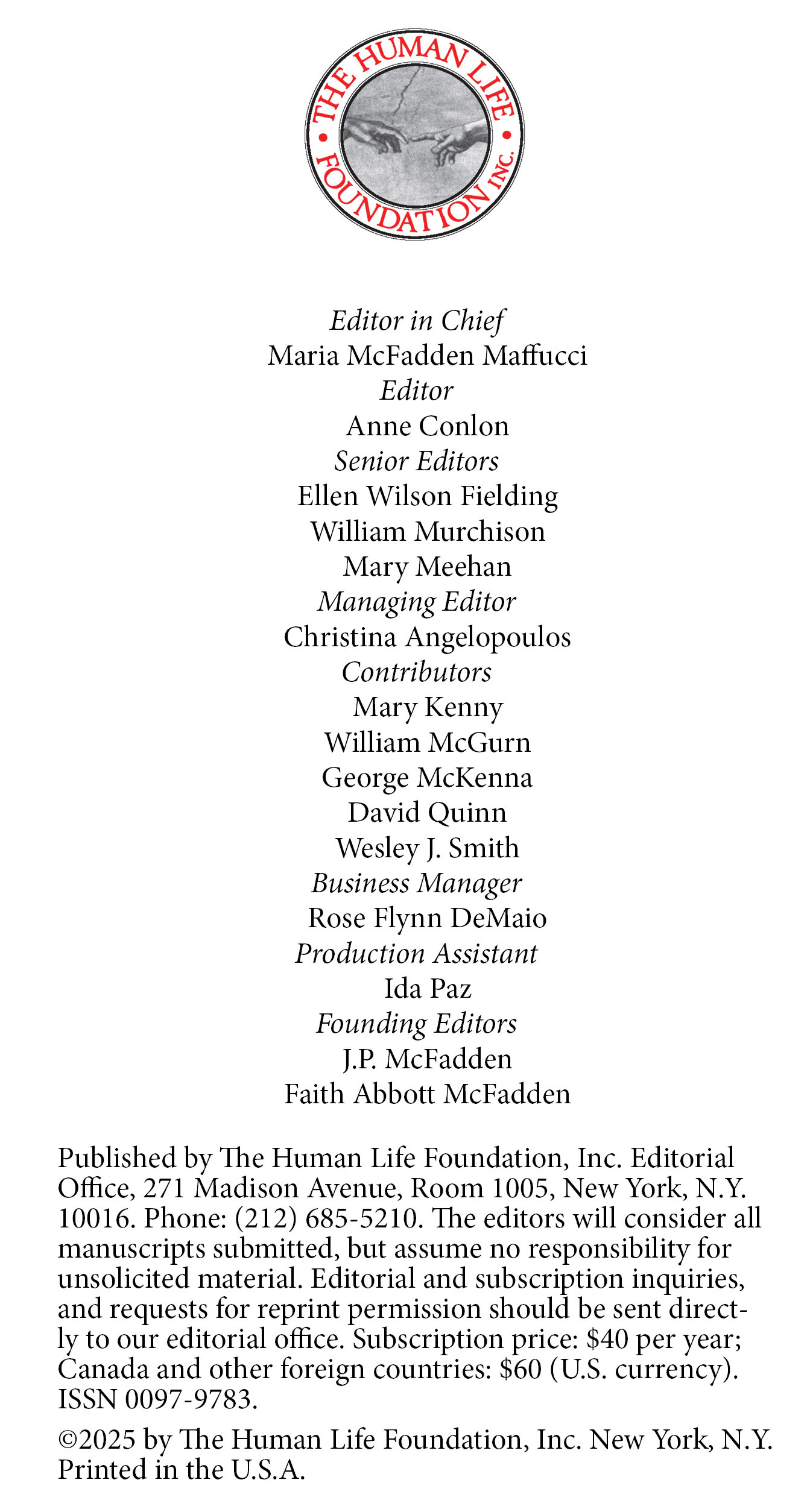| Hover and click over an underlined article to read, or select article below issue!
|
 - from the editor-in-chief . . .
. . . As we begin our 51st year of publishing, I am overwhelmingly grateful to our readers, donors—and brilliant writers!—who continue to make it possible for us to publish the truth in an increasingly destructive culture. 2025 began with some welcome news. On the eve of the 52nd annual March for Life, we learned that President Trump kept his promise and pardoned all 23 prisoners unjustly held for peaceful pro-life protests. And there are several other important pro-life gains: the restoration of the Mexico City policy, which forbids taxpayer funding of abortion overseas; a similar guidance to the Pentagon, ending its policy to cover travel for abortions; the rejoining of the Geneva Consensus Declaration, which states that there is no international right to abortion; and the Justice Department’s memo curtailing prosecutions via the FACE act against anti-abortion protestors.
As I write, however, we are in tumultuous times, and political divisions in the country are represented as well in the pro-life movement. President Trump’s video-taped speech to the March seemed to make it clear that returning the legality of abortion to the states was his definitive move; on the campaign trail, both President Trump and Vice President JD Vance evaded the abortion pill question saying that too should be left up to the states—yet the abortion pill is now the method used in the majority of abortions. (Two days after the inauguration, a coalition of pro-life leaders petitioned the Trump administration to take action on the abortion pill by reinstating safety measures and the enforcement of anti-abortion trafficking laws.) To the dismay of those in the whole-life movement, one of the president’s first executive orders intended to overturn restrictions on capital punishment and expand states’ access to lethal drugs. The Vice President, a recent Catholic, has made waves by accusing the United States Conference of Catholic Bishops of caring about the financial bottom line, not refugees, when the USCCB cautioned that, along with justice, there must be mercy, asking the government to carry out immigration enforcement in a “targeted, proportional, and humane way.” And while it is life-saving to cut off the massive exportation of contraception and abortion overseas, the “break everything first” approach to USAID funding would hurt many pro-life programs—like PEPFAR—(President’s Emergency Plan for AIDS Relief, created by President George W. Bush in 2003) and in so doing, put the lives of pregnant women and their babies at grave risk.
These are the roiling issues today; we do not know what the landscape will look like when this issue hits your mailbox. What we do know: The Human Life Review is here to promote and encourage the right to life of all human beings, and to air out and debate the differing viewpoints sincerely held by our fellow defenders of life. And that brings me back to the March. Even though the movement has always had and always will have diversity not only in religion and politics but in priorities and strategies, the March itself is a shining example (and a joyful one, see newcomer Eva Cooley on p. 94) of putting differences aside to unite in what really is the most crucial thing: to be witnesses that all human life, from conception to natural death, no matter age, race, creed, or ability, is to be valued as precious and in need of protection. An ideal in an imperfect world, yes, but one for which we may never stop striving.
Maria McFadden Maffucci
- At our 50th anniversary dinner last fall, co-host Jack Fowler rolled his eyes at the notion of “depressed” Americans who, unhappy with the election results, wanted to move to Canada: “They kill depressed people in Canada,” he quipped. That might come as a surprise to Hollywood types who make gauzy films about euthanasia, but it’s no surprise here. Since its beginning, the Review has paid close attention to post-war efforts to rehabilitate “mercy killing” in the wake of the Holocaust. And to the metastasizing number of kills in countries that have legalized what Canada calls MAID (Medical Assistance in Dying), as if doctors who administer deadly drugs really are—as Hollywood depicts them—mere servants of empowered patients seeking to schedule their own death. Hardly.
“Less than a decade into legalized assisted suicide,” writes senior editor Ellen Wilson Fielding in “The Inalienable Gift of Human Dignity,” “with annual body counts mushrooming and embarrassing stories of impoverished Canadian elderly and handicapped being counseled to consider suicide, it begins to look like Ottawa has come to consider the only good Canadian a dead Canadian.” In this wide-ranging essay, Fielding looks at modern cultural avatars like Brave New World and other dystopian novels, which “have insinuated into their futuristic social fabric various forms of expedited ‘assisted suicide’ or euthanasia.” She then makes her way back to the Old Testament, the urtext of Western civilization and repository of its erstwhile moral codes: “While our ancestors apparently resembled us in being tempted to neglect or mistreat their feeble and senile elders,” she gleans from Sirach and Job, “they differed from a good number of us in refusing to regard those elders as lacking inherent human dignity.” As in: Honor thy father and mother. (Not to mention Thou shalt not kill.)
Read More
|
